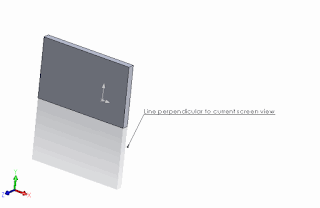Create vector normal to screen view using SOLIDWORKS API
This example demonstrates how to draw a sketch line which is perpendicular (normal) to the current view orientation relative to the screen using SOLIDWORKS API.
The line will start at the point at the middle of the screen and will be perpendicular to the screen orientation. That means that initially it will be rendered as point until view rotates.
IModelView::Transform SOLIDWORKS API property is used to extract the transformation matrix of current orientation of the view.

Dim swApp As SldWorks.SldWorks Dim swModel As SldWorks.ModelDoc2 Dim swMathUtils As SldWorks.MathUtility Sub main() Set swApp = Application.SldWorks Set swMathUtils = swApp.GetMathUtility Set swModel = swApp.ActiveDoc If Not swModel Is Nothing Then Dim swModelView As SldWorks.modelView Set swModelView = swModel.ActiveView If Not swModelView Is Nothing Then Dim swNormVec As SldWorks.MathVector Dim swMidPt As SldWorks.MathPoint Set swNormVec = GetNormalVector(swModelView) Set swMidPt = GetMidPoint(swModelView) DrawVector swMidPt.ArrayData, swNormVec.ArrayData, 0.1 Else MsgBox "Active model doesn't contain view" End If Else MsgBox "Please open the 3D model" End If End Sub Function GetNormalVector(modelView As SldWorks.modelView) As SldWorks.MathVector Dim swScreenToModelViewTransform As SldWorks.MathTransform Set swScreenToModelViewTransform = modelView.Transform.Inverse() Dim dVec(2) As Double dVec(0) = 0: dVec(1) = 0: dVec(2) = 1 Dim swNormVec As SldWorks.MathVector Set swNormVec = swMathUtils.CreateVector(dVec) Set swNormVec = swNormVec.MultiplyTransform(swScreenToModelViewTransform) Set GetNormalVector = swNormVec End Function Function GetMidPoint(modelView As SldWorks.modelView) As SldWorks.MathPoint Dim swScreenToModelViewTransform As SldWorks.MathTransform Set swScreenToModelViewTransform = modelView.Transform.Inverse() Dim dPt(2) As Double dPt(0) = modelView.FrameWidth / 2 dPt(1) = modelView.FrameHeight / 2 dPt(2) = 0 Dim swMathPt As SldWorks.MathPoint Set swMathPt = swMathUtils.CreatePoint(dPt) Set swMathPt = swMathPt.MultiplyTransform(swScreenToModelViewTransform) Set GetMidPoint = swMathPt End Function Function DrawVector(startPt As Variant, dir As Variant, length As Double) swModel.ClearSelection2 True Dim swEndPt As SldWorks.MathPoint Dim swDirVec As SldWorks.MathVector Set swDirVec = swMathUtils.CreateVector(dir) Set swDirVec = swDirVec.Normalise() Set swDirVec = swDirVec.Scale(length) Set swEndPt = swMathUtils.CreatePoint(startPt) Set swEndPt = swEndPt.AddVector(swDirVec) Dim endPt As Variant endPt = swEndPt.ArrayData swModel.Insert3DSketch2 True swModel.SketchManager.AddToDB = True swModel.SketchManager.CreateLine startPt(0), startPt(1), startPt(2), endPt(0), endPt(1), endPt(2) swModel.SketchManager.AddToDB = False swModel.Insert3DSketch2 True End Function